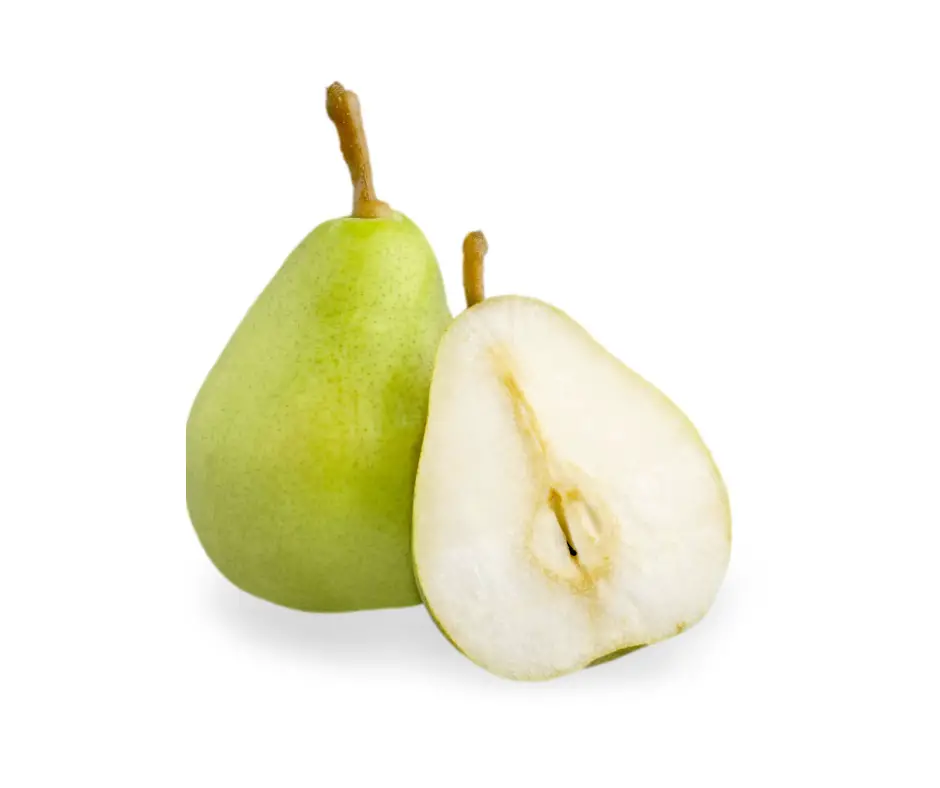Selecting a pear from your fruit basket, you might wonder: is this sweet, juicy delight best enjoyed as it is or should I explore other ways to feast upon its goodness?
Whether you’re inclined toward a raw crunch or you savor the juicy thrill of cooked and baked alternatives, pears offer a repertoire that will cater to your palate.
This article explains the different methods of consuming pear fruit, and also compares eating pear fruit raw vs cooked.
Not just that, it also explains whether it’s safe to consume pear in its entirety – skin, core and seeds, or certain portions and discard the rest.

Can You Eat Pear Skin, Core and Seed?
If you’ve ever questioned what parts of the pear are safe to consume, we’re here to set the story straight.
The skin of a pear is indeed edible and surprisingly nutritious.
It boasts an impressive amount of dietary fiber and numerous essential nutrients.
Yet, before you start peeling off that soft, crinkly exterior in fistfuls, remember to give it a good wash.
Cutting out any bruised or spoiled bits is also recommended.
Moving inward from the skin, we hit the core.
While many toss it aside viewing it as an unappetizing woody structure that’s more pit than pleasure, it’s actually quite safe to consume.
That said, due to its hardness and seed content, the majority of pear eaters prefer to avoid this part.
Speaking of seeds now; when you get a bite full of them in your pear eating endeavor – spit them out immediately.
Pear seeds do contain cyanide–a toxic substance if ingested in large quantities over time.
Although the danger is minimal unless you’re consuming a large amount of seeds daily, health-wise it’s safer just not to make a habit out of eating them and stick to enjoying the skin and flesh of the fruit instead.
Can You Eat Pear Like An Apple? Directly?
Yes, indeed, pears can be enjoyed much like apples.
Both fruits have wonderfully edible skins and cores that can be easily savored.
This means they’re perfect candidates for on-the-go snacks or quick bites without the need for complex prep work.
If you want to enjoy a pear as you would an apple, make sure you opt for one that is ripe yet firm, showing no significant signs of bruises or damage – because let’s face it, nobody wants a mushy mouthful!
Prior to sinking your teeth into its juicy flesh, don’t forget to give your pear a good rinse under water.
While the decision to peel it remains entirely at your discretion, remember that the skin holds many nutrients that you’d hate to miss out on.
What Is The Best Way To Eat Pear?
For starters, pears can be relished just as they are, eaten out of hand with their skin adding an extra element of texture.
A pear’s skin not just provides important nutrients but also preserves the juicy freshness within until you’re ready to devour it.
For those seeking an enhanced experience, slicing a pear and eating it as a snack can open up layers of culinary excitement.
Sprinkle some lemon juice for a tangy twist or perhaps add cinnamon for that warm, cozy flavor.
Pairing honey-dripped pear slices with cheese or nuts creates a delicious balance between sweet and savory that’s truly irresistible.
If you’re in the mood to experiment, you can also try juicing it.
Packed with essential nutrients and vitamins, drinking pear juice is not only refreshing but also contributes significantly towards your daily health quota.
Baking, poaching or roasting pears results in an entirely different sensory feast.
The heat coaxes out its inherent sweetness and infuses it with caramel-like undertones that complement any dessert like baked pies or tarts.
Poached pears steeped in vanilla ice cream form an elegant dessert whereas roasted pears can stand alone triumphantly on any dinner plate.
Is Pear Better Cooked Or Raw?
We’ll, for those underripe pears that stubbornly refuse to yield at the gentlest squeeze, cooking is the way to go.
Transforming these hard fruits into a syrupy delight through methods such as poaching or baking can indeed be a creative way to go about eating them.
If you’re lucky enough to have a perfectly ripe pear, the choice of eating it raw or cooked opens up a world of flavor opportunities.
Cooking adds new layers of taste and can reduce potential allergic reactions for those sensitive individuals among us.
Keep in mind though, certain cooking practices like boiling might significantly reduce some nutrients contained in pears.
But don’t let this deter you!
Opt for gentler cooking techniques like steaming, baking or roasting which not only preserve much of the fruit’s nutritional integrity but allows for cell walls to burst open and give our bodies easier access to its wealth of vitamins and minerals.
Now let’s consider the raw side of things.
The humble pear in its natural state is a nutritional powerhouse – loaded with fiber, water content and plant compounds that keep our internal engine ticking over smoothly.
A bite into raw pear benefits our gut health, manages blood sugar levels, aids in weight management, optimizes heart health and even plays a role in warding off certain cancers.
Plus, there’s no beating the sheer convenience of biting into a fresh pear as is or slicing it up for salads, smoothies or yogurts.
However – fair warning for our friends sensitive to birch pollen – consuming raw pears might trigger allergic reactions due their protein structure akin to these pollens.
Should We Drink Water After Eating Pear?
It’s a natural instinct to want to gulp some water after taking fruit.
But is this practice really beneficial?
You might be surprised to learn that while it’s not harmful, you should allow about 30 minutes after consumption before reaching for that glass of water.
Drinking water immediately after eating a pear could potentially lead to overhydration.
This doesn’t mean that a floodgate opens and you’ll become awash in too much water.
Rather, it means your body may not absorb the nutrients from the pear as effectively.
It isn’t just about potential overhydration though.
A delay before guzzling down water could also help control blood glucose spikes.
According to a 2018 study published in Clinical Nutrition ESPEN, waiting for approximately 30 minutes post-ingestion can be instrumental in managing blood sugar levels.

